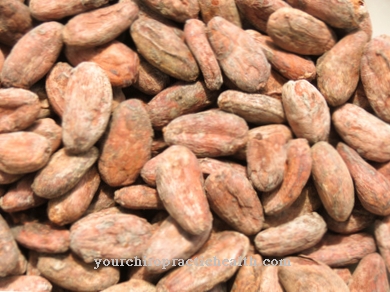Of the laurel Thanks to its aroma, it is often used as a spice in the kitchen to refine many dishes. But the plant has been valued for some time for its healing properties, for example to strengthen digestion.
Occurrence and cultivation of laurel

Of the Laurel tree or shrub grows up to ten meters high, is native to the Mediterranean region and Asia Minor and has perennial, evergreen leaves. While the bay leaves can be used by any shrub, the bay fruits are only suitable for seasoning if they come from the female plants. The leaves can be harvested in early spring and late autumn. The shrub thrives in mild climates and can be in the sun or in the shade.
Therefore it can be used in many ways. High-quality potting soil is ideal for the laurel to be grown on the balcony, terrace or in temperature-controlled winter gardens. The evergreen shrub prefers a soil that is always slightly moist. It does not tolerate waterlogging, but it can survive brief drought. In ancient Rome, emperors and sporting winners were honored with laurel wreaths. Hence the saying that you first have to earn your laurels.
Effect & application
The bay leaf is very popular in cooking, as the tremendous flavor of the leaves goes well with many dishes and brings a piquant, spicy, unique aroma into the kitchen. The freshly dried leaves have a warm, but strong aroma, which is well absorbed by the food and is much more noticeable than the taste. The floral scent is reminiscent of herbs.This can be used to season stews, soups, strong sauces, red cabbage or dishes with a long cooking time.
The leaves (without a stem) are also used for fish, poultry, sauerbraten, game, potato dishes, to flavor vinegar or to pickle cucumbers. Bay leaves also taste good in pies, ragouts and in tomato sauce. When searing meat, vegetables or onions, the bay leaves should not be added immediately, but only after the stew liquid such as broth, marinade or wine has been poured in.
Bay leaves can also be combined well with other spices, for example with caraway seeds, garlic, pepper, paprika, nutmeg and lemon peel. It is also a good idea to add a bay leaf to the cooking water of pasta, potatoes, and rice. Before serving, the laurel is always removed. To dry, the shoot tips and the mature leaves are cut off and tied together with string to hang them in an airy place. The essential oils contained in laurel are not lost.
The bay leaves should be stored in a dark, airtight and dry place. They are quite sensitive to light and also do not like excessive storage temperatures. In general, laurel should be used sparingly due to its strong flavor. For better development of the elegant aroma, the leaves can be easily torn before they are cooked. Since the taste only develops slowly, they should always be cooked. The leaves can handle the heat without any problems.
The leaves are removed again before the dishes are served. The laurel has an appetizing and antibacterial effect. But even after a meal, the laurel can be used as a tea. For a digestive tea, three dried bay leaves are boiled in one liter of water. After a steeping time of ten minutes, it is poured off and a cup drunk to relieve indigestion such as gas. The fruit oil is also used to make liqueurs, soaps and perfumes.
Importance for health, treatment & prevention
The bay leaves (in fresh or dried form) and the fruit of the tree are not only used for cooking, but also for medicinal purposes, for example due to the essential oils they contain to strengthen digestion or to alleviate women's complaints. External use against flatulence is possible in babies. The oil, which is obtained from the bay fruits, can be used as a liniment against various problems of the locomotor system.
It also relieves swelling, sprains and strains as well as rheumatic and arthritic pain thanks to its circulation-promoting effect. Laurel is also said to help against scabies and dandruff. To relieve colds and coughs, a cloth is soaked in water in which the bay leaves have been boiled. When applied to the body, it improves ailments such as colds, coughs, bronchitis and infections of the respiratory tract due to the essential oils it contains.
As an addition to inhalation, the bay leaf has a sweaty and expectorant effect. In addition, the expectoration and the healing process of the diseased bronchi are promoted. Bay leaf infusions relieve flu symptoms and lower fever. It is also believed that the use of bay leaf can also reduce the risk of diabetes (type 2) and cardiovascular diseases. In addition, the bad cholesterol should be lowered.
For processing, the leaves can be boiled and the water then used to treat a wide variety of medical problems. For indigestion relief, a tea can be made from dried bay leaves. The good quality of the dried bay leaves is shown by their dark green color. If they are browner, this indicates that they are probably older or have not been stored well. Bay leaf capsules and tinctures are also available as dietary supplements.


.jpg)






















.jpg)


